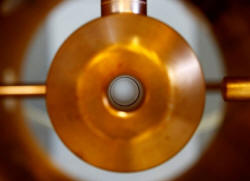|
 New
CERN particle accelerator may help both doctors and art
sleuths New
CERN particle accelerator may help both doctors and art
sleuths
 Send a link to a friend
Send a link to a friend
[May 10, 2017] By
Tom Miles
GENEVA (Reuters) - A new particle
accelerator unveiled at CERN, the European physics research center, is
expected to spawn portable accelerators that could help doctors treat
cancer patients and experts analyze artwork.
|
|
 CERN is gradually upgrading its hardware to get more data from the
Large Hadron Collider (LHC), its 27-km (17-mile) circular
accelerator that smashes protons together at almost the speed of
light to probe basic questions about the universe. CERN is gradually upgrading its hardware to get more data from the
Large Hadron Collider (LHC), its 27-km (17-mile) circular
accelerator that smashes protons together at almost the speed of
light to probe basic questions about the universe.
Its latest upgrade, resembling a 90-metre oil pipeline hooked up to
a life support machine, replaces the 39-year-old injector that
produces the flow of particles for the LHC.
Standing by the new Linac 4 machine, which cost 93 million Swiss
francs ($93 million) and took 10 years to build, project leader
Maurizio Vretenar said CERN had miniaturized the technology and saw
many potential uses.
"It's a brave new world of applications," he told Reuters in Linac
4's tunnel 12 meters under Geneva.

CERN has already built a version to treat tumors with particle beams
and licensed the patent to ADAM, a CERN spin-off owned by Advanced
Oncotherapy.
Another medical use is to create isotopes for diagnosing cancers.
Since they decay rapidly, they normally have to be rushed to
patients just in time to be used.
"With our portable technology they could be made inside the hospital
already," Vretenar said.
His next goal is a one-metre prototype weighing about 100 kgs, with
which museums could analyze paintings and jewelry. The bulk of
funding for the project came in a few weeks ago.
"We are building something portable," he said. "We already have a
collaboration with the Louvre, and with the Italians at Florence at
the Italian institute for conservation of artworks."
[to top of second column] |

The Louvre in Paris is the only museum in the world that already has
an accelerator, and when it is closed on Tuesdays, artifacts are
taken down to the basement for analysis, he said.
Other museums don't have the same luxury, and may not want to send
their artworks away for analysis.
The results take a few hours and can show which mine a piece of
jewelry came from, or detect heavy elements that date and identify
the paint used, revealing restorations or fakes.
There's no risk of damage, Vretenar said.
"We are very careful. The intensity of particles is very low," he
said. "It's not like here, there's only a few protons."
(Reporting by Tom Miles; Editing by Tom Heneghan)
[© 2017 Thomson Reuters. All rights
reserved.] Copyright 2017 Reuters. All rights reserved. This material may not be published,
broadcast, rewritten or redistributed.
 |